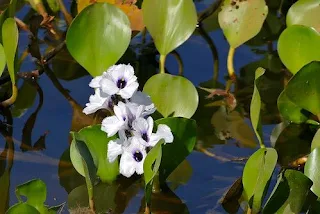Water Hyacinth Water Purification on Lake Victoria
Water Hyacinth on Lake Victoria is a Surprising Environmental Ally in Water Purification
Lake Victoria, one of Africa's Great Lakes, is renowned for its immense beauty and its vital role in the lives of the surrounding communities.
However, this pristine waterbody faces a considerable challenge in the form of water hyacinth, an invasive aquatic plant that proliferates at an alarming rate.
While often viewed as a nuisance, there is an intriguing silver lining to the presence of water hyacinth in Lake Victoria: its ability to absorb and accumulate certain pollutants from the water, including heavy metals and organic contaminants, effectively acting as a natural water purifier.
 |
| Lake Victoria water hyacinth near Junga, Uganda |
The Pervasive Problem of Water Hyacinth
Water hyacinth, known scientifically as Eichhornia crassipes, is characterized by its vibrant purple or lavender flowers and glossy green leaves. The plant's rapid growth and tendency to float on the water's surface make it a common sight in Lake Victoria. However, its rapid proliferation and ability to form thick mats pose significant challenges for the ecosystem and the communities that rely on the lake for their livelihoods.
Despite its invasive nature, water hyacinth exhibits a remarkable trait that holds promise in mitigating water quality issues. It can absorb and accumulate various pollutants from the water, including heavy metals and organic contaminants. This process, known as phytoremediation, involves the plant taking up and storing these pollutants in its tissues.
 |
| Water Hyacinth Water Purification |
Good News About Water Hyacinth Water Purification on Lake Victoria
Water hyacinth is an incredibly effective natural solution for removing heavy metals like lead, cadmium, and chromium from water. These toxic metals can seriously harm both aquatic life and human health when present in excessive amounts.
Thankfully, water hyacinth has the unique ability to absorb and store these harmful metals, significantly reducing their concentration in the water. With water hyacinth on your side, you can feel confident that your water quality is safe and protected.
Additionally, water hyacinths can absorb organic contaminants, including nutrients from agricultural runoff, which can contribute to water eutrophication. This process aids in preventing excess nutrient loading and maintaining water quality.
While the water-purifying abilities of water hyacinth are promising, it's essential to acknowledge some important considerations.
The plant's proliferation and ability to form dense mats are known to disrupt native ecosystems, block sunlight from reaching submerged aquatic plants, and deplete oxygen levels in the water. These effects can result in fish kills and harm to other aquatic life, counterbalancing the potential benefits of phytoremediation.
It's crucial to keep in mind that the environmental impact of phytoremediation can be detrimental to aquatic life, such as fish, and overpower any potential benefits.
The consequences can even lead to fish deaths and harm other organisms residing in the water. Therefore, it's necessary to take into account the possible negative outcomes of phytoremediation and weigh them against the expected advantages.
Achieving a balance between controlling and managing water hyacinths in Lake Victoria is crucial.
Efforts to control and manage water hyacinths in Lake Victoria require a delicate balance. Strategies to harness its phytoremediation abilities may be explored in areas with significant pollution issues.
These strategies include harvesting water hyacinth from affected areas and properly disposing of the contaminated plant material. However, such actions must be carefully planned to minimize the plant's ecological disruptions and address its challenges.
Lake Victoria's battle with water hyacinth is a complex and ongoing saga. While the plant's rapid growth and disruptive qualities are a cause for concern, its surprising ability to purify water by absorbing and accumulating pollutants offers hope in mitigating pollution issues.
Striking a balance between managing the invasive species and harnessing its phytoremediation potential is a challenge that requires careful consideration and continued research. Ultimately, it underscores the intricate relationship between ecosystems and the need for innovative solutions to protect this invaluable natural resource.
Using water hyacinth to treat domestic wastewater method.
Water hyacinth can be harnessed as a cost-effective and environmentally friendly method for treating domestic wastewater. This versatile plant has a natural capacity to absorb and accumulate pollutants, including organic contaminants and nutrients.
In constructed wetlands or wastewater treatment systems, water hyacinth effectively filters domestic wastewater, removing impurities and improving water quality.
It acts as a natural biofilter, reducing organic matter and nutrient levels in the water. While its application requires proper management to avoid ecological disruptions, it represents a sustainable and low-tech solution for wastewater treatment, particularly in areas with limited resources for conventional treatment processes.




